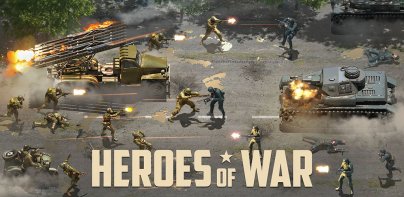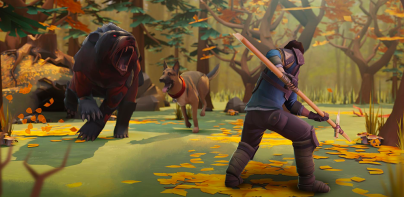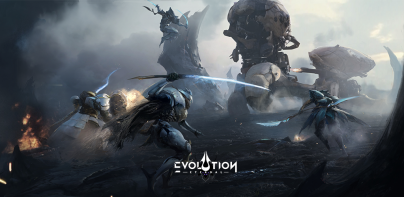


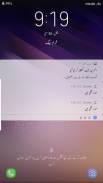
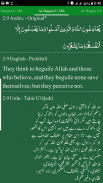
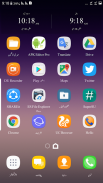
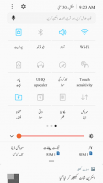
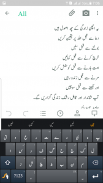



Jameel Noori Nastaleeq FlipFont

Jameel Noori Nastaleeq FlipFont का विवरण
Nastaʿlīq (Persian: نستعلیق, from نسخ Naskh and تعلیق Taʿlīq) is one of the main calligraphic hands used in writing the Persian script, and traditionally the predominant style in Persian calligraphy.[1] It was developed in Iran in the 14th and 15th centuries.[2] It is sometimes used to write Arabic-language text (where it is known as Taʿliq[citation needed] or Persian and is mainly used for titles and headings), but its use has always been more popular in the Persian, Turkic and Urdu sphere of influence. Nastaʿlīq has extensively been (and still is) practised in Iran, Pakistan, India, Afghanistan and other countries for written poetry and as a form of art.
A less elaborate version of Nastaʿlīq serves as the preferred style for writing in Kashmiri, Punjabi and Urdu, and it is often used alongside Naskh for Pashto. In Persian it is used for poetry only. Nastaʿlīq was historically used for writing Ottoman Turkish, where it was known as tâlik[3] (not to be confused with a totally different Persian style, also called taʿlīq; to distinguish the two, Ottomans referred to the latter as taʿlīq-i qadim, "old taʿlīq").
Nastaʿlīq is the core script of the post-Sassanid Persian writing tradition, and is equally important in the areas under its cultural influence. The languages of Iran (Western Persian, Azeri, Balochi, Kurdi, Luri, etc.), Afghanistan (Dari, Pashto, Uzbek, Turkmen, etc.), Pakistan (Punjabi, Urdu, Kashmiri, Saraiki, etc.), and the Turkic Uyghur language of the Chinese province of Xinjiang, rely on Nastaʿlīq. Under the name taʿliq (lit. “suspending [script]”), it was also beloved by Ottoman calligraphers who developed the Diwani (divanî) and Ruqah (rık’a) styles from it.
Nastaʿlīq is amongst the most fluid calligraphy styles for the Arabic alphabet. It has short verticals with no serifs, and long horizontal strokes. It is written using a piece of trimmed reed with a tip of 5–10 mm (0.2–0.4 in), called qalam ("pen", in Arabic and Persian قلم), and carbon ink, named davat. The nib of a qalam can be split in the middle to facilitate ink absorption.
Two important forms of Nastaʿlīq panels are Chalipa and Siah-Mashq. A Chalipa ("cross", in Persian) panel usually consists of four diagonal hemistiches (half-lines) of poetry, clearly signifying a moral, ethical or poetic concept. Siah-Mashq ("black drill") panels, however, communicate via composition and form, rather than content. In Siah-Mashq, repeating a few letters or words (sometimes even one) virtually inks the whole panel. The content is thus of less significance and not clearly accessible.
For more detail:https://en.wikipedia.org/wiki/Nasta%CA%BFl%C4%ABq_script
Nasta'līq (फारसी: نستعلیق, نسخ naskh और تعلیق Ta'līq से)। फारसी लिपि में लिखित रूप में इस्तेमाल किया मुख्य सुलेखन हाथ से एक है, और पारंपरिक रूप से फारसी सुलेख में प्रमुख शैली है [1] यह 14 वीं और 15 वीं शताब्दी में ईरान में विकसित किया गया था। [2] कभी-कभी यह अरबी भाषा के पाठ (जहां यह Ta'liq [उद्धरण वांछित] या फारसी के रूप में जाना जाता है और मुख्य रूप से शीर्षक और शीर्षकों के लिए प्रयोग किया जाता है) लिखने के लिए प्रयोग किया जाता है, लेकिन इसके उपयोग हमेशा की फारसी, तुर्की और उर्दू क्षेत्र में अधिक लोकप्रिय हो गया है प्रभावित करते हैं। Nasta'līq बड़े पैमाने पर किया गया है (और अभी भी है) ईरान, पाकिस्तान, भारत, अफगानिस्तान और लिखित कविता के लिए अन्य देशों में और कला का एक फार्म के रूप में अभ्यास किया है।
Nasta'līq का एक कम विस्तृत संस्करण कश्मीरी, पंजाबी और उर्दू में लिखने के लिए पसंदीदा शैली रूप में कार्य करता है, और यह अक्सर पश्तो के लिए naskh के साथ प्रयोग किया जाता है। फारसी में यह केवल कविता के लिए प्रयोग किया जाता है। Nasta'līq ऐतिहासिक तुर्क तुर्की, जहां यह रूप में Talik [3] (एक पूरी तरह से अलग फारसी शैली, यह भी कहा जाता है ta'līq साथ भ्रमित होने की नहीं जाना जाता था लिखने के लिए इस्तेमाल किया गया था, दो भेद करने के लिए, तुर्क के रूप में उत्तरार्द्ध में भेजा ta'līq-मैं क़ादिम, "पुराने ta'līq")।
Nasta'līq बाद सस्सनिद फारसी लेखन परंपरा के मूल स्क्रिप्ट है, और इसकी सांस्कृतिक प्रभाव में क्षेत्रों में समान रूप से महत्वपूर्ण है। ईरान की भाषाओं (पश्चिमी फारसी, अज़ेरी, बलूची, Kurdi, Luri, आदि), अफगानिस्तान (दारी, पश्तो, उज़्बेक, तुक्रमेन, आदि), पाकिस्तान (पंजाबी, उर्दू, कश्मीरी, सरैकी, आदि), और झिंजियांग के चीनी प्रांत के तुर्की उईघुर भाषा, Nasta'līq पर भरोसा करते हैं। नाम ta'liq (अर्थात, "[स्क्रिप्ट] निलंबित") के तहत, यह भी तुर्क सुलेखक जो दीवानी (Divani) और Ruqah (rık'a) से शैली विकसित द्वारा प्रेमिका थी।
Nasta'līq अरबी वर्णमाला के लिए सबसे अधिक तरल पदार्थ सुलेख शैलियों के बीच है। यह कोई serifs के साथ छोटे कार्यक्षेत्र, और लंबे समय क्षैतिज स्ट्रोक है। यह, 5-10 मिमी (0.2-0.4) के एक टिप के साथ छंटनी की ईख के एक टुकड़े का उपयोग कर लिखा है कहा जाता qalam ( "कलम", अरबी और फ़ारसी قلم में), और कार्बन स्याही, नामित davat। एक qalam की निब स्याही अवशोषण की सुविधा के लिए बीच में विभाजित किया जा सकता।
Nasta'līq पैनल के दो महत्वपूर्ण रूपों Chalipa और Siah-Mashq हैं। एक Chalipa ( "पार", फारसी में) पैनल आमतौर पर कविता की चार विकर्ण hemistiches (आधे लाइनों) के होते हैं, स्पष्ट रूप से एक, नैतिक नैतिक या काव्य अवधारणा का सूचक है। Siah-Mashq ( "काले ड्रिल") पैनलों, तथापि, रचना और फार्म के माध्यम से संवाद नहीं बल्कि सामग्री की तुलना में। Siah-Mashq में, उसमें कुछ अक्षर या शब्द दोहरा (कभी कभी भी एक) लगभग पूरे पैनल स्याही। सामग्री कम महत्व के इस प्रकार और नहीं स्पष्ट रूप से सुलभ है।
अधिक विस्तार के लिए: https: //en.wikipedia.org/wiki/Nasta%CA%BFl%C4%ABq_script





